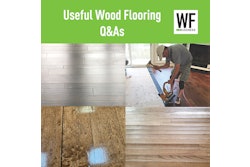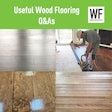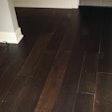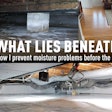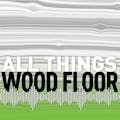Fasteners & Cupping
I am installing a solid 5-inch-wide plank floor, and I’m concerned about the floor cupping in summer months. If I use additional fasteners or adhesive in addition to nailing, will that help prevent cupping?
Brett Miller, VP of education and certification at the National Wood Flooring Association, answers:
No, anything you do to help fasten the floor to the subfloor is solely for holding power. Cupping is caused by only one thing: a moisture imbalance throughout the thickness of the wood. Kerfing the backside of the planks might help limit cupping somewhat, but adding more fastening power to the floor will not prevent the wood from changing shape when it takes on moisture. In fact, adding too many fasteners (more than recommended for the width of the flooring you’re using) creates the risk of causing splits or cracks in the tongue, allowing movement in the floor and potentially causing squeaks.
If you’re concerned about cupping, you have to think about controlling the environmental conditions in the home and using the right product for that home. As long as you have control of what’s underneath the flooring (crawlspace, basement, subfloor moisture conditions), your floor will only be affected by what goes on in the ambient conditions in the space above. Use of humidifiers/dehumidifiers are key to controlling RH throughout the year. It is your responsibility to discuss control of these conditions with the customer. If the homeowners won’t be using humidity control to keep RH within an acceptable range, then solid wide plank flooring might not be the best choice. Sell them the product that best suits their situation.
RELATED: How to Prevent Cupping and Worse in Summer Months
Pinless Problems
I’ve been having problems with my pinless moisture meter seeming to give inaccurate readings. What would cause this?
Paul Laurenzi, VP of sales and marketing at Towaco, N.J.-based Delmhorst Instrument Co., answers:
Some of the issues that can throw off reading accuracy include damage (scratches, dents, etc.) to the scanning plate, damage to the PC board (from drops, heat stress or water), uneven surfaces, the objects being measured being too thin, failure to correct for specific gravity based on species, and low batteries.
It’s important to test your moisture meter’s accuracy before each job. For pinless moisture meters, there are three ways to check meter calibration. First, you can use a reference meter. To do this, the pinless meter is used to scan the floor or subfloor, and then a second reference meter is used on the same spot. It is important to use two of the same make and model moisture meter to ensure that both have been calibrated to the same standards. The second method is to use a special sensor block from the moisture meter manufacturer. These sensor blocks are created to return a specific percentage MC reading when scanned by a pinless meter. If your meter measures a value other than the one specified for that sensor block and pinless meter, then you know that the meter’s readings are off, and by how much.
Third, some pinless moisture meters have a built-in calibration check that lets you know on the spot if your meters are reading right. Make sure you check with the manufacturer of your specific meter for their directions on meter calibration.
RELATED: Avoid These Mistakes When Moisture Testing Wood Floors
Consumer RH Control?
How can I encourage customers to control the humidity levels in their home to prevent wood floor problems?
Randy Lenz, humidification product specialist at Madison, Wis.-based Aprilaire answers:
Consumers are often shocked by the damage indoor RH levels can cause to a wood floor—but they often learn about it only after their floor has sustained damage. Depending on climate and season, humidity can be too high or too low, and in many regions, RH is at one extreme in the winter and the other in the summer. Reducing the swings is essential to prevent damage.
In the winter, heating the home greatly reduces RH, creating air that is dry and thirsty.
In the winter, heating the home greatly reduces RH, creating air that is dry and thirsty. Explain to consumers that this dry air quenches its thirst by drawing moisture out of anything it can find, including hardwood floors. In the summer, high humidity creates a hot, sticky feeling. This means RH is too high and wood floors may swell and cup. If the air conditioning is running, high humidity can also make us feel cold and clammy. It’s important for consumers to understand that temperature control and climate control are not the same.
Consumers must be educated on the indoor humidity in their homes. One step a wood floor retailer can take is to sell hygrometers and encourage customers to monitor RH levels. Retailers who sell hygrometers and proactively educate consumers about RH problems tell us those initiatives have greatly reduced callbacks. Of course, providing a solution is essential. By partnering with or recommending a local HVAC expert, wood floor retailers can help their customers tackle RH issues head on with the use of whole-home humidifiers and dehumidifiers.
RELATED: How Inside Air Affects Wood Floors
















